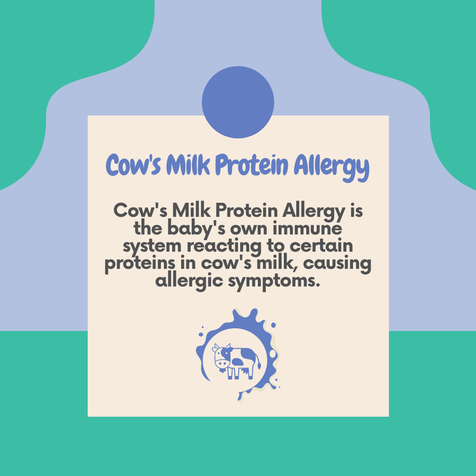|
Adverse reactions to cow’s milk can occur at any age from birth, including in infants who are exclusively breastfed. It’s worth knowing that clinicians will often use the term ‘cow’s milk hypersensitivity’ to include some reactions that are not allergic.
An allergic reaction to cow’s milk is a reproducible immune system-mediated reaction to one or more proteins in the milk. There are two types of allergic reactions; immediate, which occur 0–2 hours after consumption (IgE-mediated), and delayed, which occur from two to 48 hours later. It’s important to know what type of allergic reaction your infant or child has because this will define the investigations and the management plan. In terms of symptoms, infants can develop a sudden rash (urticaria), swelling (angioedema), projectile vomiting, refusing the breast or bottle just after they begin feeding, and exhibiting signs that they are in pain. Parents may see changes in the bowels with blood or mucous in the stools. Many infants become distressed and have sleepless nights crying. This is a stressful time that affects the whole family. If you suspect CMPA, see an allergy specialist as soon as possible. Some infants can develop eczema in the first few months of life, and this should not be mistaken for an allergic rash. However, an infant with eczema may also develop an allergy to cow’s milk and in this case, parents will notice an additional rash and eczema flare that may be difficult to control. This is also the case for infants with gastro-oesophageal reflux. They can have vomiting (non-projectile) after feeding and frequently exhibit pain, arching their backs after feeding and being unsettled. A detailed allergy history will guide your GP to make the right referral and begin treatment. When the medical history leads to the diagnosis of an immediate allergic reaction, a skin prick test or blood tests should be carried out. In cases where the allergic reaction is delayed, the diagnosis is made through the principle of elimination and re-introduction under the guidance of a dietitian which includes six weeks of avoidance followed by re-introduction. Breastfeeding mums can try to eliminate all milk and dairy from their diet for four weeks to see if the symptoms resolve. If avoidance is required, then Mum should receive Calcium and Vitamin D supplements. If there is still no sign of improvement, they should bring milk and dairy back to their diet as soon as possible. Some infants or toddlers can develop CMPA when they start weaning and are introduced to fresh cow’s milk. The symptoms are the same and a timely diagnosis and management plan are needed. The treatment is an avoidance of cow’s milk (fresh and in foods). Infants can receive a special formula that contains extensively hydrolysed milk proteins (e-HF). In some cases, only under the guidance of an allergy specialist, infants can be given an amino-acid formula (AAF) which is completely stripped of the proteins. It is not recommended for infants to start with this formula before trying the extensively hydrolysed formula first. Infants and children would require monitoring and in time, milk can be slowly re-introduced in their diet following a strict protocol. This is referred to as the milk ladder and should be designed and agreed with a specialist dietitian. Children and young people have a particularly good chance of growing out of their allergy to cow’s milk. This can be achieved with regular allergy tests and guidance from an allergy specialist and dietitian. Note: please do not mistake lactose intolerance with CMPA. Lactose intolerance is a non-allergic hypersensitivity. |
AuthorAneta Ivanova Archives
March 2023
Categories |
The Consulting Rooms, 38 Harborne Road, Birmingham, B15 3EB
[email protected]
Website design & content by LIT Communication: www.litcommunication.com
[email protected]
Website design & content by LIT Communication: www.litcommunication.com


 RSS Feed
RSS Feed